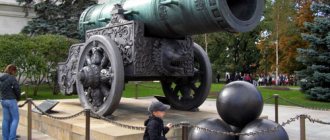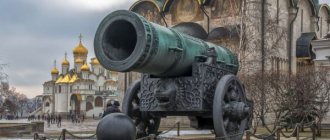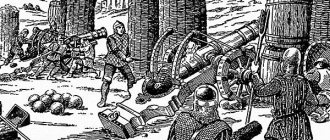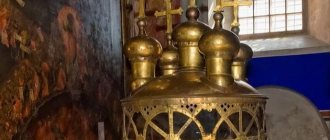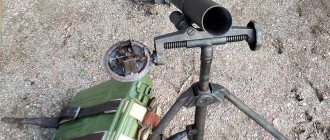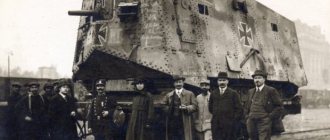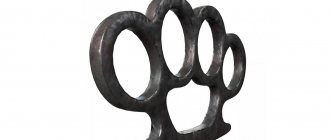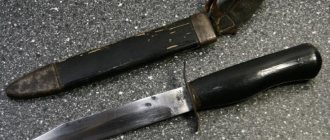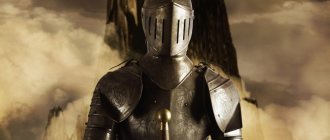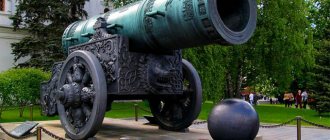On January 7, 1598, Russian Tsar Fyodor Ioannovich, the last of the Rurik dynasty, died in Moscow. During his reign, many significant events took place. Several cities were founded: Saratov and Samara, Voronezh and Tsaritsyn (now Volgograd), Tobolsk and Arkhangelsk, Surgut. The borders of the actively developing Russian State have been strengthened. The Russian-Swedish war was completed and Russia regained access to the Baltic Sea.
As you can see, there are many worthy deeds, but Tsar Fedor was also remembered for the creation of a monument, which still stands in the Kremlin on Ivanovskaya Square. If you have ever been there on an excursion, then you have seen two unique objects - the Tsar Cannon and the Tsar Bell.
As a rule, when describing them, guides say that the huge bell never rang, and the cannon never fired a single shot. But it is not so. Despite the fact that this huge artillery piece, from the point of view of military experts, was never such, a shot was fired from the Tsar Cannon, but only once.
Development of artillery in Russia
The cannon appeared in the 14th century, when gunpowder was invented. The first firearms were characterized by imperfect design due to low technical capabilities. The cannons had iron barrels. The gunpowder was a dark paste, and the cartridge looked like a container with a handle; it was fixed in the barrel using wedges. The cartridges often exploded when fired, seriously injuring nearby people with shrapnel if they did not have time to hide.
In the 15th century, gunpowder began to look like a free-flowing substance. It was poured into the trunk through the barrel and carefully compacted. The cannonball, previously wrapped in rags, was pushed into the cannon until it came into contact with gunpowder. As artillery production technology developed, the caliber increased.
Weapons of significant caliber, used to destroy fortress walls, were called “bombards”. This name also applies to the Tsar Cannon.
In Russia, the era of artillery began in the 16th century. At the beginning of the 18th century, there were as many as 9,500 artillerymen. Guns began to be cast using a mold consisting of 12 elements, or having a longitudinal split. The gun was molded in a horizontal position. The molding blank was wooden, intended for repeated use. Factories were erected where weapons were cast, and buildings where gunpowder was made and stored.
Description
The Tsar Cannon is a medieval artillery piece, or, more precisely, a bombard. It has a length of 5.34 m, the outer diameter of the barrel is 120 cm, the caliber of the gun is 890 mm, it weighs 39.31 tons. The barrel length is six calibers, therefore, according to the modern classification, the Tsar Cannon is a mortar.
The master who cast the Tsar Cannon richly decorated it with various reliefs and inscriptions. On the right side of the muzzle of the gun there is a relief depicting Tsar Fyodor I Ioannovich, during whose reign this marvelous monument of foundry art was made. The Russian autocrat is depicted on a horse with a crown on his head, and in one hand he holds a scepter. There are inscriptions on the barrel, from which you can find out when and by whom the Tsar Cannon was made. Some historians believe that the name of the cannon appeared precisely because of the image of the king on it. Although, most likely, it is due to the huge size of the weapon.
On each side of the barrel there are four brackets designed for transporting the gun.
The bore of the Tsar Cannon is interesting. Inward from the muzzle, it has the shape of a cone, with an initial diameter of 900 mm and a final diameter of 825 mm. The charging chamber also resembles a cone: its initial diameter is 447 mm, and its final diameter (the one at the breech) is 467 mm. The bottom of the chamber is flat.
Story
It is reliably known when the Tsar Cannon was invented. The idea came to the mind of the then Russian Tsar, but not the real one, but the actual one - Boris Godunov. According to his idea, the Tsar Cannon personified the strength of the state and was also a protective symbol. Boris Godunov also hoped to increase the people’s favor towards him in this way.
There are two versions of the origin of the name. According to the first, the cannon was named in honor of Tsar Fyodor Ivanovich; according to the other, the name emphasizes the huge size of the weapon.
Technically, the bronze cannon was a real weapon ready for battle. It was created specifically to protect the Spassky Gate and the place where they crossed the Moscow River.
Manufacturing
At the instigation of Boris Godunov, Tsar Fyodor Ivanovich ordered the creation of the Tsar Cannon in 1586. It is known who created the artillery miracle: the name of the foundry master Andrei Chokhov has been preserved in history. In those years, the threat of invasion by the Crimean Horde loomed over Moscow.
The huge cannon was dragged by 200 horses to Red Square, where it was installed on Lobnoye Mesto. At first they placed the Tsar Cannon on a log flooring, but after a while they decided to create a stone one. So the gun stood for intimidation. The Tsar Cannon was almost used in battle when in 1591 the army of Khan Kazy II Geray approached Moscow, but the trouble passed.
Rearrangements
In the 18th century, the cannon was moved to the Kremlin. At first it stood in front of the Arsenal, where Peter I collected captured and historically significant weapons. In 1843, the cannon, as a monument to artillery history, was placed near the Armory, where other ancient guns were located. Architect Bryullov designed a cast-iron carriage for the Tsar Cannon, on which it was mounted.
In 1960, the barracks located on the site of the old Armory Chamber were destroyed to build the Palace of Congresses. And the Tsar Cannon was moved to the northern wall of the Ivan the Great bell tower.
Device features and design
The Tsar Cannon is unique in size; it cannot be classified into a specific category of artillery weapon. The caliber correlates with the barrel length with a value of 6: by modern standards, such a weapon is considered a mortar. But in the 17th century, mortars had a barrel-to-caliber ratio of no more than 3.5. A real cannon has a value of at least 40. By design, the Tsar Cannon can be called a shotgun.
The main substance in the chemical composition of weapons is copper, its amount is 91.6%. The Tsar Cannon also contains: lead, tin, arsenic, antimony, nickel, aluminum, zinc, manganese.
The Tsar Cannon looks ceremonial and pompous. The bombard is decorated with patterns. The carriage, cast according to the drawings of the Dutch master Pieter Jan de Wie, is decorated with floral motifs, into which the image of a lion overcoming a snake is woven. The floral pattern continues on the wheel spokes. On the right side of the trunk you can see Tsar Fyodor Ivanovich sitting on a horse.
On the Tsar Cannon you can see the phrase: “The cannon maker Andrei Chokhov worked on the creation of the cannon.” There are transport fastenings on the sides of the barrel.
So this is a classic bombard!
Bombards first appeared at the end of the 14th century. The name "bombarda" comes from the Latin words bombus (thunderous sound) and arder (to burn). The first bombards were made of iron and had screw-mounted chambers. For example, in 1382, in the city of Ghent (Belgium), the “Mad Margaret” bombard was made, named in memory of the Countess of Flanders Margaret the Cruel. The caliber of the bombard is 559 mm, the barrel length is 7.75 calibers (klb), and the bore length is 5 klb. The weight of the gun is 11 tons. “Mad Margarita” fired stone cannonballs weighing 320 kg. The bombarda consists of two layers: the inner one, consisting of longitudinal strips welded together, and the outer one, made of 41 iron hoops welded together and with the inner layer. A separate screw chamber consists of one layer of disks welded together and is equipped with sockets into which a lever was inserted when screwing it in and out.
Loading and aiming large bombards took about a day. Therefore, during the siege of the city of Pisa in 1370, every time the besiegers prepared to fire a shot, the besieged went to the opposite end of the city. The besiegers, taking advantage of this, rushed to attack.
The bombard's charge was no more than 10% of the core's weight. There were no trunnions or carriages. The guns were laid on wooden blocks and frames, and piles were driven in behind or brick walls were erected for support. Initially, the elevation angle did not change. In the 15th century, they began to use primitive lifting mechanisms and cast copper bombards
Please note that the Tsar Cannon does not have trunnions, with the help of which the gun is given an elevation angle. In addition, it has an absolutely smooth rear section of the breech, with which it, like other bombards, rested against a stone wall or frame
Did the Tsar Cannon ever fire?
According to the generally accepted opinion of historians, the Tsar Cannon was created solely to intimidate a potential enemy. It was never fired, and could not be fired due to the massiveness of the structure. Probably, Andrei Chokhov himself knew that he was not creating a cannon for fighting: this was the tsar’s order. Restorers who examined the gun in the 1980s came to the conclusion about the decorative and terrifying significance of the weapon. They noticed relief defects in the barrel, and there were no signs of cleaning of the cast weapon. But the main feature of decorative purposes is the absence of a seed hole.
Some historians believe that the Tsar Cannon did fire. Upon careful examination of the weapon, traces of gunpowder were found inside.
There is even a legend about when the Tsar Cannon fired. This happened at the end of the reign of False Dmitry I. The exposed impostor tried to escape from Moscow. But they found him and dealt with him cruelly. The mutilated body of the false prince was buried, and the next morning it lay at the gates of the almshouse. The frightened and surprised residents again buried the corpse even deeper. But the next morning it appeared on the surface again. There was a rumor that the impostor was cursed and the earth was rejecting him. Then they burned the body, mixed the ashes with gunpowder, hammered it into a cannon, and fired it in the direction of the Polish-Lithuanian Commonwealth, because that’s where the false ruler was sent.
In 1941, when the German army was approaching Moscow, it was planned to use the Tsar Cannon along with other weapons to repel the enemy attack.
Next to the Tsar Cannon lie large cast iron cannonballs. They are also ancient, they were cast in 1835. Each core weighs 2 tons. But they have a purely decorative function. It is impossible to use them for shots. If you push them into a cannon, the barrel will explode when fired. Historians believe that if the Tsar Cannon fired, it was only with stone shells weighing up to 1 ton, or with buckshot.
Literature
- Gordeev N.V.
Tsar Cannon. - M: Moscow worker, 1969. - 56 p. — 60,000 copies. - Portnov M.E.
Tsar Cannon and Tsar Bell. - M: Moscow worker, 1990. - 48 p. — ISBN 5-239-00778-0. - Pozdnev A.
Creators of domestic weapons. - M: Military Publishing House of the USSR Ministry of Defense, 1955. - Lobin A. N.
New data on the tools of the “Chokhov School” of the late 16th - early 17th centuries / Efimov S. V. - St. Petersburg: VIMAIViVS, 2014. - T. III. - Zakharikov G.M.
On the combat purpose of the Tsar Cannon. Monuments of architecture and technology. Collection of history of natural science and technology of the USSR Academy of Sciences. - M, 1984. - Sharkovsky D.
Victory weapons of Russia. IX - XXI centuries - M: IDionomiks, Eksmo, 2015. - 248 p. — 1500 copies. — ISBN 978-5-699-75291-1. - Lubchenkov Yu. N., Bogatskaya I. A., Tikhomirova A.
The Kremlin. - M.: White City, 2009. - 416 p. — 10,000 copies. — ISBN 978-5-7793-1638-5. - Yudakov I.
Moscow Kremlin. Red Square. Guide. - Veche, 2007. - 208 p. — 5000 copies. — ISBN 978-5-9533-2395-6.
Other big guns
The Tsar Cannon cannot but inspire foundry masters. It is not surprising that in recent times, copies of the Moscow landmark and similar weapons have appeared in Russia and abroad.
In 2001, two almost exact copies of ancient weapons were made. Each specimen weighs 42 tons, and each core made for them weighs almost 1.5 tons. Material of manufacture: cast iron. The factory workers installed one cannon near the entrance of the Izhevsk plant. And the second copy went to Donetsk. There the cannon was installed on Artem Street. This was a reciprocal gesture to the gift presented - a copy of the palm tree of the blacksmith Alexei Mertsalov.
In 2007, in Yoshkar-Ola, on Obolensky-Nogotkov Square, its own Tsar Cannon appeared. It is 2 times smaller than the original, and the patterns decorating the cannon are noticeably simplified. This cannon is made of steel, equipped with 4 cannonballs, and weighs 12 tons with them. It was made at the Butyakov Shipbuilding and Repair Plant in Zvenigovo.
Permians can also boast of their copy of Moscow weapons. Moreover, the Perm gun is a combat gun that has passed tests. With its help, 300 shots were fired, the ejected cannonballs covered a distance of 1.5 km. The Perm cannon was not made to decorate the square; its original purpose was to be installed in the maritime part of Kronstadt to protect the northern borders of the state.
Appearance of an antique watch
Previously, a different number system was used in Russia / Photo: chrome-effect.ru
In Russia, before Peter I came to the throne, a completely different number system was used - Cyrillic. In it, all the numbers were written not in the way we are used to, but in letters. One could also see the Glagolitic alphabet, but the principle is similar. As for our clock from the tower, here the numbers were written in two rows: one row - Cyrillic symbols, the second - Arabic.
The first watch was created by Christopher Galovey / Photo: ruxpert.ru
Their creator in 1624 was Christopher Galovey, an engineer from England. Already in 1628 after a fire they had to be reconstructed. The clock was restored later, and the reason was the same as in the case of the first reconstruction.
Like all such mechanisms in Russia, the Kremlin watches were called “Russian” by residents of other countries. What they looked like at that time caused surprise and bewilderment among many. As for Galovey, he explained this decision with humor.
He said that Russians are generally special, acting unconventionally, as is customary throughout the world, and therefore everything they produce should be done completely differently. The dial in the mechanism was painted azure. This was a symbol of heaven. On top there was a painting in gold and silver in the form of the sun, stars, and moon.
In the first watch, it was not the hand that moved, but the dial / Photo: yandex.ua
There were no arrows familiar to us. They were replaced by a single fixed hand at the top of the dial. She imitated a sunbeam. The most interesting thing is that in this case it was the dial that was moving. He performed a rotation around this lonely hour hand.
The first version of the watch was distinguished by its unusual division into two segments of different sizes, and 17 instead of 12, as we are used to, sectors. Each of the sectors had its own letter and a number that corresponded to it. Between these numbers there were “half hours” - dots.
The Frolov clock (at one time the tower was called not Spasskaya, but Frolovskaya) from that time can now be seen in a sketch by the Austrian Ambassador Meyerberg, made in 1661. Forty years after this, after another fire, the clock was destroyed and not restored.
Mention in historical sources
The Tsar Cannon is described in detail and picturesquely by the Polish-Lithuanian hussar Samuil Matskevich. Being a man of the noble family, he visited Moscow in 1610 together with the Polish hetman and diplomat Alexander Gonsevsky. What amazed him most in the Kremlin was the Tsar Cannon.
In his notes, Matskevich said that the Kremlin was completely built up with houses of boyars, churches, and monasteries. There were four gates: some were directed towards the Moscow River, others towards Ivangorod. The Frolov Gate was decorated with the capital's coat of arms - “an eagle on a ball,” as the nobleman wrote. The Kremlin is separated from China Town by a high and impressive wall, as well as a deep moat with stone decoration. On these walls and towers there were innumerable quantities of artillery and siege weapons.
Matskevich further describes the Tsar Cannon: “In the middle of the market I saw a mortar, cast, it seems, only for display. Having sat in it, I couldn’t reach the upper side of the canal with my head by an inch. And our hussars usually climbed into this gun, three at a time, and played cards there under the fuse, which served as their window.”
Why exactly seventeen numbers?
The 17 sectors on the dial were not chosen by chance / Photo: zhiznteatr.mirtesen.ru
The time has come to talk about the “zest” of these ancient watches, which was responsible for their uniqueness and made the mechanism “Russian”. Why not 12, but 17 sectors. In fact, the choice of just such a number of them was not accidental.
Every hour of the day was accompanied by the sound of a bell / Photo: yandex.ua
In Russia at that time, time was calculated according to night and day hours. At Moscow latitude, the duration of the shortest night was 7 hours, and the longest day was 17. This is exactly what the founder displayed on the product.
The principle of operation was simple. After sunrise, watchmakers set the dial in such a position that the hand was pointing to 17. An hour later, the hand was at “1,” which means it was the “first hour of the day.” The action was accompanied by the sound of a bell.
On June 22 (the longest day), the dial moved independently to sector 17, after which night came. It ended in the sector with the number 7. The watchmakers again manually set the clock to the number 17 as soon as the first rays of the sun appeared.
The burnt antique watches were replaced by the classic ones familiar to everyone / Photo: yandex.ua
To take into account all changes in the duration of night and day throughout the year, an adjustment of one hour was made to the hour readings every two weeks. There is an opinion that for the purpose of reminder, a special bell was rung once every fourteen days.
The clock that disappeared without a trace in the fire in 1704 was replaced by a classic device with a standard appearance and twelve sectors. This clock was ordered by Peter I in Amsterdam. Thus, the “Russian” division of time counting, night and day, was abolished. And this is the merit of the first Russian emperor.
